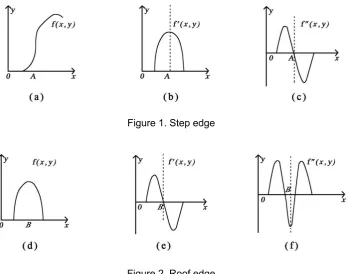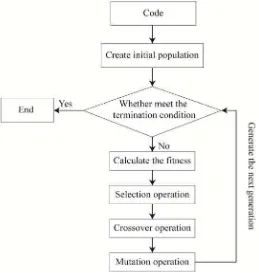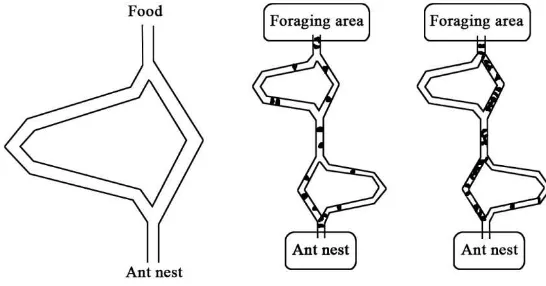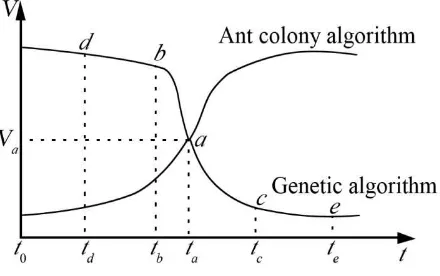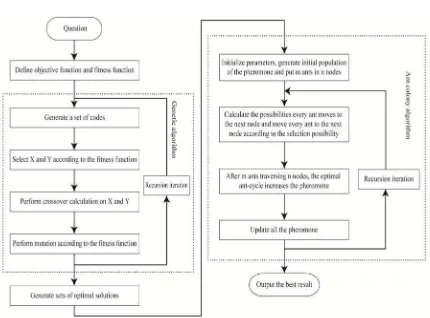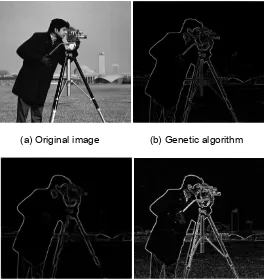DOI: 10.12928/TELKOMNIKA.v13i1.1264 118
Image Edge Feature Extraction and Refining Based on
Genetic-Ant Colony Algorithm
Xing Zhang*, Shuai Liu
Department of Computer Science and Engineering, Henan University of Urban Construction, Pingdingshan 467064, Henan, China
*Corresponding author, e-mail: [email protected]
Abstract
Edge is composed by a collection of its nearby pixels which has a step change or changes in roof, an image is an information system and most of its information comes from the edges. This paper gives a brief overview of the status and the importance of image edge detection and introduces the research status of the image edge detection. After that, it introduces the basic principle and the main steps of the genetic algorithm and ant colony algorithm. On the basis of these, the paper proposed a new hybrid algorithm for the image edge extraction and refining, which combined the genetic algorithm and ant colony algorithm. Through the analysis of the time-speed graph of the genetic algorithm and the ant colony algorithm, we can find the best fusion point between the genetic algorithm and the ant colony algorithm. The experiment indicated the proposed hybrid algorithm can make the full use of the image information, the simulation time is shorter, the image edge is more continuous, and preserved the outline of original image more completely.
Keywords: image edge detection, genetic algorithm, ant colony algorithm
1. Introduction
Edge refers to the collection of pixels the gray level of the surrounding pixels of which has step change or roof change. Edge is the important information in the image as well as a significant clue of visual perception. Actually, it can not only convey most of the image information, but it is also an important foundation of image analysis and machine vision. An image is an information system and a great deal of its information is provided by its contour edges. Therefore, edge feature extraction and detection play a significant role in image processing [1]. Although active research has been made on edge detection algorithm in the long term, the edge detection methods increase day after day and numerous edge extraction operators have been come up with gradually, the traditional Roberts operator and Sobel operator have been rarely used alone [2]. Currently, an increasing number of scholars have applied bionics algorithm in image edge detection.
In bionics algorithm, the edge detection based on genetic algorithm and that based on ant colony algorithm have their own advantages and disadvantages. In the operation of genetic algorithm, it can be found that the individuals of the population have a relatively rapid iteration speed at the initial stage; however, as the algorithm proceeds to the later period, redundant iteration emerges obviously and the iteration speed at this time is very slow [3]. As for ant colony algorithm, in its early phase, the convergence speed of the system is slow due to the lack of pheromone; nevertheless, the convergence speed accelerates on account of the positive feedback of the algorithm at the late phase and ant colony algorithm has excellent parallelism and global search ability.If the advantages of genetic algorithm are to be integrated with those of ant colony algorithm, the performance of genetic-ant colony hybrid algorithm can be improved [4],[5].
transforms its current optimal solution as the matrix distribution of the initial pheromone concentration of ant colony algorithm and operates ant colony algorithm. After the algorithm ends, output the edge image.
2. Image Edge Detection
Most important information of the image exists in the image edge, which is the most prominent in the image local changes. It reflects the feature differences within theimage local areas and it is indicated as certain discontinuity of the image information [6]. Edge mainly exists between objective and objective, objective and background as well as area and area (including different colors) and it is animportant foundation of the image analysis such as image segmentation, texture features and shape features [7]. Edge is mainly expressed as the discontinuity of image local characteristics and it contains the relatively severe gray level changes in the image, that is, the place withsingular changes in the signal. The gray level change of singular signal becomes increasingly dramatic along the edge. We generally divide the edge into two types: step and roof, which are indicated in Figure 1 and Figure 2 [8].
(a) Step, namely the image intensity has significant differences between the pixel gray levels of two discontinuous positions [9].
(b) Roof, namely the image intensity suddenly changes from one value to another and then returns to the original value after maintaining a small schedule [10].
Figure 1. Step edge
Figure 2. Roof edge
3. Feasibility Analysis of Integration of Genetic Algorithm & Ant Colony Algorithm 3.1. Principle of Genetic Algorithm
As a random and high-efficient global search method to solve problems, genetic algorithm needs no prior knowledge of its search space, instead, it approximates the optimal solution step by step through the information exchange between individuals, by randomly generating the initial population in the search space and with the help of the objective function [12].
(i) The codes can perform corresponding coding on the problems to be settled. Since the image gray level value is between 0-255, the code of every chromosome is an 8-digit binary code.
(ii) If the population model has excessive populations, the amount of calculation of every generation of fitness value is huge; however, if the population is small, it is difficult to demonstrate species diversity. Therefore, set the population number reasonably.
(iii) Fitness function is the standard to evaluate every individual and it needs to be selected to show the evolution trend. Here, choose the fitness function as the basis for ant colony parameter selection.
(iv) Completely copy the individuals with high fitness function in the population to the next-generation population. Set a random function and select the copied individuals with the widely-used selection method, namely Roulette wheel selection in the ant colony algorithm to make it as the selected operator.
(v)Crossover uses the method of single-point crossover. Select two chromosomes. Set a random function to determine a common point of these two chromosomes randomly as the crossover point of these chromosomes. After the crossover, keep the positions of the nodes of these two chromosomes from the source point to the crossover point unchanged the interchange the node positions from the crossover point to the destination point.
(vi) Mutation determines the local searching ability of genetic operation. The flowchart of genetic algorithm is as follows[13],[14].
3.2. Concrete Realization of Ant Colony Algorithm
Many kinds of ants release pheromone and pheromone direction in food foraging. Deneubourg explains this kind of path selection mode based on self-organization with a simple test model. In this mode, a bridge with two bypasses of equal length separates the ant nest and the food. At the beginning, the ants select from these two paths according to the same probability since there is no pheromone distribution in the paths. With the introduction of random fluctuation, more ants will choose one path, which increases the pheromone concentration of this path; therefore, it will attract more ants to select this path.
In Deneubourg’s experiment, the left-over pheromone concentration on the path is in direct proportion to the number of ants and no pheromone volatilization is taken into account. In this simplified model, the ant chooses a path according to the total quantity of the ants passing this path. Assume that Aiand Bi are the numbers of ants to select path A and Brespectively
Formula(1) has quantized this selection mode. Parameter ndetermines the non-linearity of the selection function. When n is bigger, the pheromone concentration of one path is only a little higher than that of the other path, then the probability for the next ant to choose the previous path is bigger. Parameterk reflects the attraction of the unmarked path. If kis bigger, then it has higher requirements on the necessary pheromone concentration to perform non-randomized selection. This kind of probability expression form is actually inferred from the actual ant path selection experiment. The parameters suitable for experiment are n2and
20
k . If Ai Bi&Ai 20, then PA 1, if Ai Bi but Ai 20, then PA 0.5. The dynamic selection result of the system is determined by the following formulas
1
Figure 4. Principle of ant path search
will reach the food source and go back to the nest earlier. Then the pheromone on the shorter path will be enhanced at a shorter time, causing more ants to choose this shorter path [15].
The above circumstances haven’t taken the constitution, placement and volatilization of pheromone. There are various diversified actual pheromone left-over methods in the natural environment. The research personnel has only obtained some fundamental features of pheromone through experiment, including, volatilization rate, absorption rate and diffusion coefficient. The research proves that pheromone can be preserved on the path for a long time, which has a close relationship with the type, population rule and environmental conditions of ants.
3.3. Feasibility Analysis
Genetic algorithm is a universal method to solve optimization problems, which has been widely used in various optimization problems. However, because of its strong universality, it has relatively bad flexibility. For lack of infinite application range, although it can ensure that it has global convergence ability on most problems, local degeneration is difficult to avoid and it fails to process the feedback information of the system. The calculation efficiency reduces when huge inefficient and redundant iterations repeat when searching to a certain degree. Ant colony algorithm achieves the purpose to converge to the optimal path through the accumulation and updating of pheromone and it has distributivity, parallelism and global searching ability; nevertheless, it is short of pheromone at the early stage and its solving efficiency is not high. In order to complement each other’s advantages of these two algorithms, it can be found from the research of these two algorithms that they present the Speed-Time Curves in Fig. 5 in solving problems [16].
Figure 5. Speed-time curve of ant colony algorithm and genetic algorithm
The genetic algorithm has a fast solving speed at the early solving period (during
0 ~ a
4. Strategy of Mutual Integration of Genetic Algorithm and Ant Colony Algorithm
It is the key for the algorithm of this paper to seek the optimal connection time for genetic algorithm and ant colony algorithm and the following dynamic integration strategy can achieve the purpose of dynamically mutual integration of genetic algorithm and ant colony algorithm.
At the beginning of genetic-ant colony hybrid algorithm, conduct genetic algorithm till the set termination condition. Transfer the current optimal solution from genetic algorithm as the distribution matrix of the initial pheromone concentration of ant colony algorithm. Implement ant colony algorithm until the optimal solution is sought.
In this paper, max-min ant-colony algorithm(MMAS) is adopted to update the pheromone. When setting the initial pheromone of ant colony algorithm, set the initial value of the pheromone on every path as the maximum value tmaxand the initial value0 can be set as a fixed number, namely 100.According to the distribution of the initial pheromone transferred from the previous genetic algorithm, we can set the initial value of the pheromone in resourceias:
0 pheromone value transferred from the second-best solution obtained from the early genetic algorithm.
The realization steps of genetic-ant colony hybrid algorithm are as follows: (i)The construction of the initial population
We have expressed every parameter with 16-digit binary coding and we have had a group of parameters (4 parameters) for every individual; therefore, we indicate every individual in the initial population with 64digit binary coding. 1 to 16digit is the value of pheromone impact factor of state transfer probability; 17 to 32digit is the value of the impact factor of heuristic direction function, 33 to 48digit is the value of the pheromone volatilization coefficient while 49 to 64digit is the number of iterationsN.
(ii)The design of objective function
Randomly put martificial ants in npixels and evaluate the effects of the final edge extraction image generated by every individual with objective function. When a corresponding group of parameters to the individual obtains the final edge image through edge extraction and if the iterative edge image has small difference with the original image, namely that the two images are basically the same, it proves that the edge of the objective object has been found. Therefore, we introduce the similarity std2 value of two images for evaluation.
The objective function is expressed as Objvstd2( )u . Here, uis the energy difference between the iterative edge image and the original image, namelyu I1I2.
(iii)The selection of the next pixel to visit
To every artificial ant,Gkis the collection of nodes which haven’t been visited before.Sk
is the collection of nodes which allow to be visited in the next step according to probability transfer formula. tabukis the search tabutable, which is the collection of nodes which have been visited before.
In Formula (4), Cijis a state variable which is obtained from the transfer formula of ant
[ ( )] [ ( )]
In Formula (5), is the pheromone heuristic factor, is the impact factor of heuristic
direction function; allowed
k is the next pixel allowed to visit and ( )
k ij
p t is the probability that ant
kmoves from pixel ito pixel jat momentt. .
(iv) Updating of the pheromone concentration of every pixel
The pheromone on the path between two pixels is not accumulated infinitely. This paper updates the pheromone with MMAS by setting a pheromone scope [min,max] to prevent the algorithm from being trapped in local convergence because of the infinite increase of local pheromone.
(a)The updating mechanism of global pheromone
(1 ) ( )
ij ij t Q
(6)
Here, is the pheromonevolatilization coefficient with its value range within0~1. Q
refers to the value of the initial pheromone.Qmaxin order to increase the searching scope at the beginning.
(b)The updating mechanism of local pheromone
For the kthant, the pheromone incrementij on the path it passes by is:
Here,is the pheromone volatilization coefficient and1 is the pheromone coefficient remained between iterationst and iterationst1. Qis a constant of the remaining trajectory
number. min k
T is the shortest operation time after the ant has gone through all the walking steps. In the initial moments,ij 0.
(v) If it meets the established end conditions, exit the algorithm, otherwise, return to Step (3).
Decode the initial population (namely every individual) randomly generated from genetic algorithm. Then conduct ant colony algorithm evolution on the edge extraction according to a corresponding group of parameters to every individual. Finally, get the final result of an iteration, namely the image edge detection result.
Figure 6. Flowchart of genetic-ant colony hybrid algorithm
5. Experiment Simulation & Analysis
Simulate this experimental result and data in the environment of Windows 7 with Intel (R) Core2CPU 1.33G and a memory of 2.5G through Matlab R2012a.
For the convenience of comparison, compare the genetic-ant colony hybrid algorithm proposed in this paper with single genetic algorithm and single ant colony algorithm with the same parameters. The algorithm parameters are set as follows: the population size of genetic algorithm is g n m, the crossover probability ispc0.8, the mutation probability ispm0.05 ,the size of ant colony algorithm ish n m, the pheromone heuristic factor is3, impact factor of heuristic direction function is 1and the pheromone volatilization coefficient is0.1
The experiment will conduct 5 analog simulations to the edge detection of every algorithm and choose the optimal effects as the final results. Figure 7 reflects the simulation results by different algorithms.
(a) Original image (b) Genetic algorithm
(c)Ant colony algorithm (d)Genetic-ant colony algorithm
Figure 7. Image edge feature extraction results by different algorithms
6. Conclusion
As the most fundamental feature, edge carries the majority of the image information. This paper analyzes the advantages and disadvantages of genetic algorithm and ant colony algorithm; integrates the advantages that genetic algorithm has fast convergence speed in the early phase and that the ant colony algorithm has strong global searching ability and applies it in image edge feature extraction and detection.As shown in the experiment simulation result, genetic-ant colony hybrid algorithm can detect the image edge quickly and accurately with obvious edge details, excellent continuity and complete edge expression to reach the expected objective.
References
[1] Anhar R, Palaiahankote S, Chee SC, Chew LT. A Robust Arbitrary Text Detection System for Natural Scene Images. Expert Systems with Applications. 2014; 41(18): 8027-8048.
[2] Yuan Y, Haobo L, Xiaoqiang L. Semi-Supervised Change Detection Method for Multi-Temporal Hyper spectral Images. Neuro computing. 2015; 148(19): 363-375.
[3] Oscar C, Evelia L, Jose S, Patricia M, Fevrier V. New approach Using Ant Colony Optimization with Ant Set Partition for Fuzzy Control Design Applied to The Ball And Beam System. Information Sciences. 2015; 294(10): 203-215.
[4] RM Rizk-Allah, Elsayed MZ, Ahmed AES. Hybridizing Ant Colony Optimization with Firefly Algorithm for Unconstrained Optimization Problems. Applied Mathematics and Computation. 2013; 224(1): 473-483.
[6] JM Prats-Montalbán, A Ferrer. Statistical Process Control Based on Multivariate Image Analysis: A New Proposal for Monitoring and Defect Detection. Computers & Chemical Engineering. 2014; 71(4): 501-511.
[7] Gajanan KB, Vijay HM. Blind Method for Rescaling Detection and Rescale Factor Estimation in Digital Images Using Periodic Properties of Interpolation. AEU - International Journal of Electronics and Communications. 2014; 68(7): 644-652.
[8] Ronghua S, Liping Q, Licheng J, Rustam S, Yangyang L. Change Detection in SAR Images by Artificial Immune Multi-Objective Clustering. Engineering Applications of Artificial Intelligence. 2014; 31(5): 53-67.
[9] Ian W, Nicholas B, David S. A Performance Evaluation of statistical Tests for Edge Detection in Textured Images. Computer Vision and Image Understanding. 2014; 122(5): 115-130.
[10] Hazem MAO. Semi-fragile Watermarking for Grayscale Image Authentication and Tamper Detection Based on An Adjusted Expanded-Bit Multiscale Quantization-Based Technique. Journal of Visual Communication and Image Representation. 2014; 25(5): 1064-1081.
[11] Hanshan L, Junchai G. Research on Target Photoelectricity Track Method and Improved Image Processing Arithmetic in Dynamic Targets Detection System. Optik - International Journal for Light and Electron Optics. 2014; 125(14): 3590-3595.
[12] Pourya H, Mahrokh GS. Efficient Contrast Enhancement of Images Using Hybrid Ant Colony Optimisation, Genetic Algorithm, and Simulated Annealing. Digital Signal Processing. 2013; 23(3): 879-893.
[13] Arash G, SMR Kazemi, Farhad M, Mohammad MN. A Cooperative Ant Colony Optimization-Genetic Algorithm Approach for Construction of Energy Demand Forecasting Knowledge-Based Expert Systems. Knowledge-Based Systems. 2013; 39(2): 194-206.
[14] Mirosław T. Ant Colony Optimization Algorithm Applied to Ship Steering Control. Procedia Computer Science. 2014; 35: 83-92.
[15] Ehsan M, Mahmoud M, Avi C, Sara M, Graham C. Efficient Transit Schedule Design of Timing Points: A Comparison of Ant Colony and Genetic Algorithms. Transportation Research Part B: Methodological. 2012; 46(1): 217-234.
[16] Ali RN, Mohammad HF, Seyed TAN. A Fuzzy Vendor Managed Inventory of Multi-Item Economic Order Quantity Model under Shortage: An Ant Colony Optimization Algorithm. International Journal of Production Economics. 2014; 155(7): 259-271.
[17] Sener A, G Mirac B, Adil B. Hybridizing Ant Colony Optimization via Genetic Algorithm for Mixed-Model Assembly Line Balancing Problem with Sequence Dependent Setup Times between Tasks.
